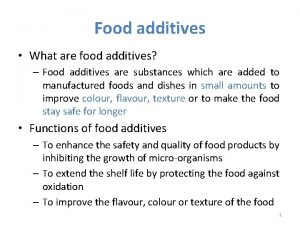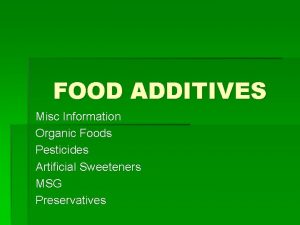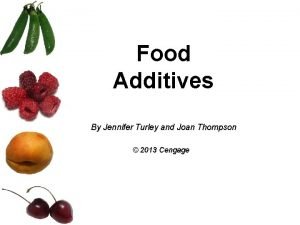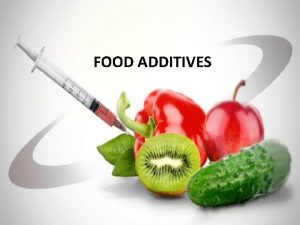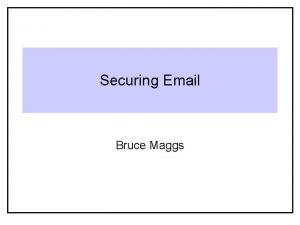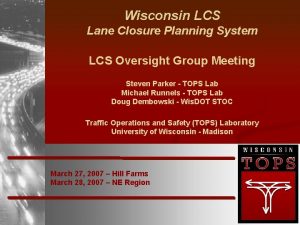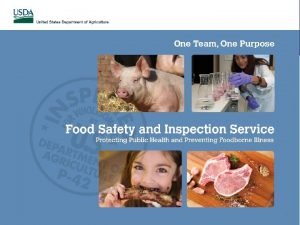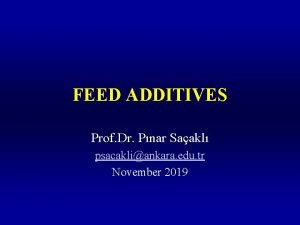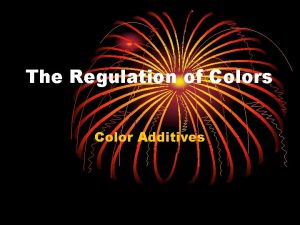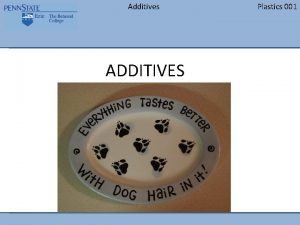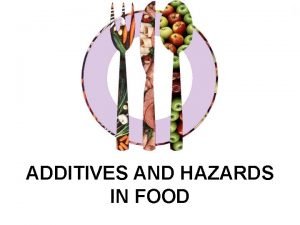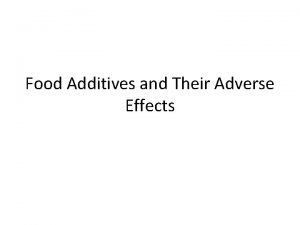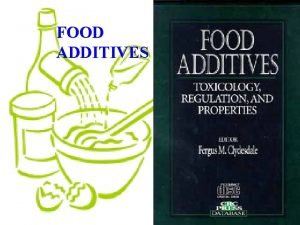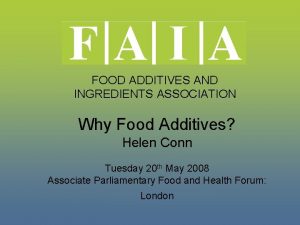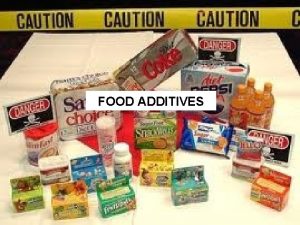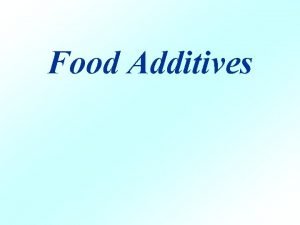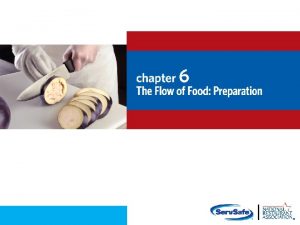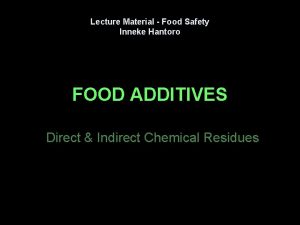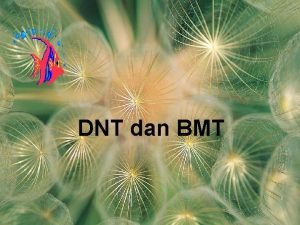Reevaluation of the safety of permitted food additives




















- Slides: 20

Re-evaluation of the safety of permitted food additives: • Update on the re-evaluation • Roadmap for the follow-up of EFSA reevaluation scientific opinions • Call for scientific and technical data on sorbic acid - sorbates

Re-evaluation programme q Commission Regulation (EU) No 257/2010 sets up a programme for the re-evaluation of approved food additives, in accordance with Regulation (EC) No 1333/2008 q All additives authorised before 20 January 2009 • Colours to be re-evaluated by 31. 12. 2015 Artificial colours with higher priority • Sweeteners to be re-evaluated by 31. 12. 2020 Aspartame by 30. 11. 2013 • All other additives to be re-evaluated by 31. 12. 2018 Preservatives and antioxidants by 31. 12. 2015 Emulsifiers, stabilisers, gelling agents, Silicon Glutamates by 31. 12. 2016 dioxide, 2

Re-evaluation procedure When re-evaluating an approved food additive, EFSA shall: a) examine the original opinion and the working documents of the Scientific Committee on Food (‘SCF’) or EFSA; b) examine, where available, the original dossier; c) examine the data submitted by the interested business operator(s) and/or any other interested party; d) examine any data made available by the Commission and Member States; e) identify any relevant literature published. 3

State of play re-evaluation by EFSA • 316 food additives approved before 20 January 2009 to be re-evaluated by EFSA • So far EFSA has issued 71 scientific opinions on the re -evaluation of the safety of food additives, covering 102 individual food additives • 214 food additives still need to be re-evaluated by EFSA before 31 December 2020

State of play re-evaluation by EFSA Type of food additive N° of additives to be re-evaluated N° of additives already re-evaluated N° of additives still to be re-evaluated Colours 41 38 3 Sweeteners 16 1 15 Additives other than colours and sweeteners 259 63 196 Total 316 102 214

Type of issues identified by EFSA in the re-evaluation scientific opinions • So far EFSA has not identified a major safety concern (such as a proven carcinogenic or genotoxic activity) for any of the re-evaluated food additives • In most cases EFSA re-confirms the safety of the food additive at its currently reported use and use level

Type of issues identified by EFSA in the re-evaluation scientific opinions However, for some additives EFSA has identified issues that require a follow-up, such as: • The safety of an additive could not be re-evaluated and/or Acceptable Daily Intake (ADI) derived due to the lack of relevant toxicological data (a so-called “inconclusive opinion”) • EFSA lowered the ADI due to the limited availability of toxicological data. • The exposure assessment carried out by EFSA suggests a potential exceedance of the ADI for one or more population groups. • EFSA raised issues concerning the specifications of some additives laid down in Commission Regulation (EU) No 231/2012

Modification of the authorisation of some food additives as a consequence of EFSA's safety re-evaluation • Regulation (EU) No 232/2012: restriction of the use food colours Quinoline yellow, Sunset Yellow and Ponceau 4 R. • Regulation (EU) No 380/2012: removal and restriction of the use of aluminium containing additives. • Regulation (EU) No 505/2014: introduction of maximum levels for the use of ammonia caramel in beer • Regulation (EU) No 957/2014: removal of montan acid esters

Approach for follow-up of EFSA's reevaluation scientific opinions • Additives whose re-evaluation by EFSA was hindered by limited data availability but which are not expected to pose an immediate food safety concern are not going to be right away banned or their uses and use levels revised. • Business operators will be requested to provide, by a certain deadline, the new data needed to complete the risk assessment, revise ADI, address exposure issues and/or specifications issues. • Once the new data has been assessed by EFSA (if appropriate) or the Commission, the current authorisation of the additive may be revised, if needed. • If the business operators indicate no further interest for an additive under reevaluation and therefore provide no new data, a withdrawal of the current authorisation can be envisaged. No additional calls for data will be organised

Approach for follow-up of EFSA's reevaluation scientific opinions The approach for the follow-up of EFSA's re-evaluation opinions does not represent a “second chance” for provision of data since: • The calls for data issued by EFSA for the re-evaluation of the safety of food additives concern existing/available data. • Only after the analysis of the available data EFSA can identify if there are data gaps, which are described in the re-evaluation scientific opinions. • In general, new toxicological studies are needed to generate those data. Business Operators should continue providing EFSA all available data in response to EFSA's calls for data

Approach for follow-up of EFSA's reevaluation opinions: other general remarks • Most issues raised by EFSA in the re-evaluation are additivespecific and therefore the follow-up should be additive per additive. • Requests for extension of use of re-evaluated additives will not be processed until the issues raised by EFSA are satisfactorily addressed. • The number of additives requiring a follow-up and the different nature of the issues raised by EFSA in the re-evaluation scientific opinions make it necessary to organise the follow-up on the basis of a risk-based prioritisation approach

Approach for communication to, and consultation of, business operators • Communication to business operators via a dedicated web page on the new data needed to complete the risk assessment of an additive/to address issues identified by EFSA. LINK: http: //ec. europa. eu/food/safety/food_improvement_a gents/additives/re-evaluation/index_en. htm • This web page also includes information about the status of the re-evaluation programme. Business operators are encouraged to visit that page regularly to remain updated about the follow-up of EFSA's safety re-evaluation of individual food additives.

13

Calls for scientific and technical data from individual food additives • • • Background Main conclusions of EFSA scientific opinion Overall purpose of this call for data Scientific and technical data required Procedure of the call for data üStep 1: Registration of the contact details of business operators interested in submitting data üStep 2: Confirmation of data submission, deadlines and milestones • • • Procedure for submission of the required data Confidential data Possibility for EFSA to use the data for the safety assessment of the same substance under other legal or regulatory frameworks

Calls for scientific and technical data from individual food additives • Step 1: Registration of the contact details of Business Operators interested in submitting data • Business Operators are requested to communicate to the Commission within 6 weeks whether they are interested that the additive remains permitted and therefore whether they are interested in providing the new data. • The Commission receives and publishes in the web site the list of Business Operators interested in submitting data in order to facilitate interactions among them and possibly coordination in the data submission.

Calls for scientific and technical data from individual food additives • Step 2: Confirmation of deadlines and milestones data submission, • Business Operators have 3 months to confirm submission of new data (6 months if new toxicological studies are needed to generate the data) • The 6 -month deadline should allow Business Operators to make plans for the toxicological studies, and, if needed/possible, to form consortia for sharing the costs of studies • The confirmation of the intention to submit data from Business Operators also includes a timeline for data submission as well as milestones.

Calls for scientific and technical data from individual food additives • List of data that will be submitted, deadlines and milestones will be published in the web site after completion of step 2 • Once the new data are received, they are submitted to EFSA for evaluation and preparation of a scientific opinion, if appropriate. • A risk management decision (whether an additive remains permitted and its uses/use levels, specifications) will be taken on the basis of the outcome of analysis of the new data submitted. No additional calls for data will be organised

Food additives whose re-evaluation follow-up will start first 1. Sorbic acid (E 200), potassium sorbate (E 202), calcium sorbate (E 203) 2. Chlorophyllins (E 140(ii)), Cu-chlorophylls (E 141(i)) and Cuchlorophyllins (E 141(ii)) 3. Iron oxides and hydroxides (E 172) 4. Sulfur dioxide (E 220), sodium sulfite (E 221), sodium bisulfite (E 222), sodium metabisulfite (E 223), potassium metabisulfite (E 224), calcium sulfite (E 226), calcium bisulfite (E 227) and potassium bisulfite (E 228) 5. Octyl gallate (E 311) and Dodecyl gallate (E 312) 6. Benzoic acid (E 210), sodium benzoate (E 211), potassium benzoate (E 212) and calcium benzoate (E 213) 7. Sodium stearoyl-2 -lactylate (E 481) and calcium stearoyl-2 -lactylate (E 482)

Call for scientific and technical data • additives sorbic acid (E 200), potassium sorbate (E 202) and calcium sorbate (E 203). Published: 10/06/2016, step 2 • sulphur dioxide (E 220), sodium sulphite (E 221), sodium bisulphite (E 222), sodium metabisulphite (E 223), potassium metabisulphite (E 224), calcium sulphite (E 226), calcium bisulphite (E 227) and potassium bisulphite (E 228). Published: 10/10/2016, step 1 closed • Call for scientific and technical data on the permitted food additives iron oxides and hydroxides (E 172). Published: 5/12/2016, Web Link: http: //ec. europa. eu/food/safety/food_improvement_agents/ad ditives/re-evaluation/index_en. htm

More information European Commission, Directorate General for Health and Food Safety, Website Food Improvement Agents: http: //ec. europa. eu/food/safety/food_improveme nt_agents/index_en. htm 20
 Acetic acid examples
Acetic acid examples Organic food additives
Organic food additives Intentional food additives examples
Intentional food additives examples Natural and artificial food additives
Natural and artificial food additives Food technology revision
Food technology revision Food additives definition
Food additives definition Réévaluation des immobilisations en algérie
Réévaluation des immobilisations en algérie Relay not permitted thunderbird
Relay not permitted thunderbird Cable manufacturers association
Cable manufacturers association Wisdot lcs
Wisdot lcs Control measures for physical hazards
Control measures for physical hazards Mixture liquid dosage form
Mixture liquid dosage form Plasticizer example
Plasticizer example Incidental additives examples
Incidental additives examples Saakl
Saakl High performance additives
High performance additives Color additives amendment
Color additives amendment Unit 2 food food food
Unit 2 food food food Food chain sequence
Food chain sequence Hát kết hợp bộ gõ cơ thể
Hát kết hợp bộ gõ cơ thể Frameset trong html5
Frameset trong html5
